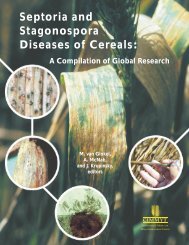Section 3 (Crop Management)
Section 3 (Crop Management)
Section 3 (Crop Management)
Create successful ePaper yourself
Turn your PDF publications into a flip-book with our unique Google optimized e-Paper software.
Maize-rice rotation in Thailand<br />
On-farm test of nitrogen fertilization for maize grown after rice<br />
A study consisted of two experiments was conducted at PSL FCES followed by an on-farm test<br />
during the dry season of 1998/1999. A split plot in RCB design with four replications was used in the first<br />
experiment. Maize cv. NS 72 was planted under different nitrogen fertilizers in terms of timing and its<br />
amounts of application. The following experiment was conducted at the various farmers’ field and was<br />
separatedinto two plots namely 50 kg N ha -1 applied as a top-dressing fertilizer (30 days after planting)<br />
and 120 kg N ha -1 splitted into basal and top-dressing fertilizers. In the first experiment, data was<br />
analyzed the same as in experimental 3. The Student t-test and marginal rate of return (MRR) was also<br />
used to compare in the second experiment.<br />
Results and Discussion<br />
Maize after rice as compared to the second rice<br />
Maize and second rice grown well during a dry season due to adequate water consumption and<br />
fertilizer application. As displayed in Table 1, the costs of production in maize and second rice were<br />
found to be similar i.e. 13,125 baht ha -1 for maize and 13,750 baht ha -1 for rice, respectively.<br />
Benchaphun et al. (2001) reported that more than 80 % of the costs in maize production was variable<br />
costs, 50 % being labor costs and 30 % was material costs. In addition, labor costs were composed of<br />
mostly land preparation and harvesting costs. In terms of material costs, the largest item was fertilizer cost<br />
and seed costs. However, maize produced 18 % of kernel yield greater than those of the second rice.<br />
Maize also gave 36 % of incomes and 141 % of profits better than the second rice.<br />
Limits to productivity<br />
<strong>Crop</strong> yields were generally lower in intercrops. Since most crops, particularly maize, were developed<br />
as monocrops, there was a need to develop variety and management techniques to increase the<br />
productivity of maize in rice-based cropping system. From the experience of the authors, the experiment<br />
station yield for maize grown under post-rice condition was 10 ton ha -1 , researcher’ s yield in farmers’<br />
fields was 7.5 ton ha -1 , and farmers’ yield was only 5 ton ha -1 . Pandey (1986) suggested that the gap<br />
between experiment station yield and researchers' yield in farmers’ fields was caused by environment and<br />
soil factors, and the gap between researchers' and farmers’ yields was due to technical resources and<br />
social factors.<br />
The reasons for yield differences between potential and farmers’ average yield levels could be<br />
summarized as follows:<br />
1. lack of suitable maize varieties for post-rice condition;<br />
2. seeds not readily available to farmers during dry season;<br />
3. poor stand, causing lack of quality seeds;<br />
4. delay planting time due to delay the staple crop ;<br />
5. poor water drainage resulting from poor soil management, causing heavy-soils textured ;<br />
6. poor water distribution resulting from poor water management, causing water logging and<br />
moisture stress;<br />
7. poor N fertilizer management resulting from amounts and timing of application.<br />
- 309 -









